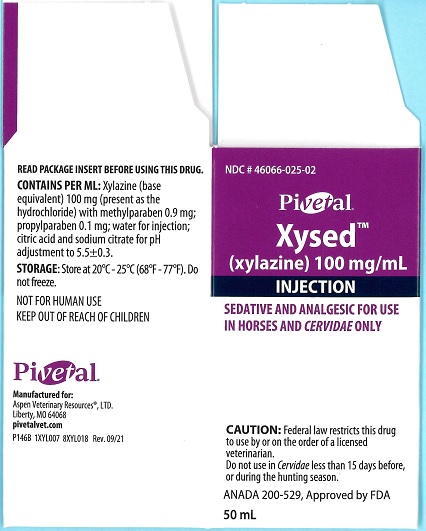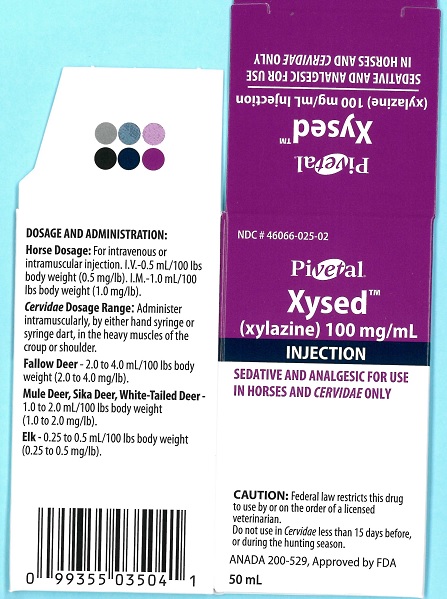Xysed by Aspen Veterinary Resources / Bimeda, Inc. / Bimeda-MTC Animal Health
Xysed by
Drug Labeling and Warnings
Xysed by is a Animal medication manufactured, distributed, or labeled by Aspen Veterinary Resources, Bimeda, Inc., Bimeda-MTC Animal Health. Drug facts, warnings, and ingredients follow.
Drug Details [pdf]
XYSED- xylazine injection, solution
Aspen Veterinary Resources
----------
Xysed™
(xylazine) 100 mg/mL Injection
SEDATIVE AND ANALGESIC FOR USE IN HORSES AND CERVIDAE ONLY
CAUTION
Federal law restricts this drug to use by or on the order of a licensed veterinarian.
Do not use in Cervidae less than 15 days before, or during the hunting season.
DESCRIPTION
Xysed™ (xylazine) is supplied in 50 mL multiple-dose vials as a sterile solution. Each mL contains 100 mg Xysed™ (xylazine base equivalent); 0.9 mg methylparaben; 0.1 mg propylparaben; water for injection; citric acid and sodium citrate for pH adjustment to 5.5 ± 0.3.
ACTIVE INGREDIENT:
xylazine hydrochloride ....................................................................11.7%
(Equivalent to 10% base)
INERT INGREDIENTS: ..................................................................88.3%
100.0%
PHARMACOLOGY
Xysed™ a non-narcotic compound, is a sedative and analgesic as well as muscle relaxant. Its sedative and analgesic activity is related to central nervous system depression. Its muscle-relaxant effect is based on inhibition of the intraneural transmission of impulses in the central nervous system. The principal pharmacological activities develop within 10 to 15 minutes after intramuscular injection, and within 3 to 5 minutes following intravenous administration in horses.
A sleeplike state, the depth of which is dose-dependent, is usually maintained for 1 to 2 hours, while analgesia lasts from 15 to 30 minutes. The centrally acting muscle relaxant effect causes relaxation of the skeletal musculature, complementing sedation and analgesia.
In horses and Cervidae under the influence of Xysed™ the respiratory rate is reduced as in natural sleep. Following treatment with Xysed™ the heart rate is decreased and a transient change in the conductivity of the cardiac muscle may occur, as evidenced by a partial atrioventricular block. This resembles the atrioventricular block often observed in normal horses.1, 2, 3, 4 Although a partial A-V block may occasionally occur following intramuscular injection of Xysed™, the incidence is less than when it is administered intravenously. Intravenous administration of Xysed™ causes a transient rise in blood pressure, followed by a slight decrease.
Xysed™ has no effect on blood clotting time or other hematologic parameters.
INDICATIONS
Xysed™ should be used in horses and Cervidae (Fallow Deer, Mule Deer, Sika Deer, White-Tailed Deer, and Elk) when it is desirable to produce a state of sedation accompanied by a shorter period of analgesia.
Horses: Xysed™ has been used successfully as follows:
1. Diagnostic procedures-oral and ophthalmic examinations, abdominal palpation, rectal palpation, vaginal examination, catheterization of the bladder and radiographic examinations.
2. Orthopedic procedures, such as application of casting materials and splints.
3. Dental procedures.
4. Minor surgical procedures of short duration such as debridement, removal of cutaneous neoplasms and suturing of lacerations.
5. To calm and facilitate handling of fractious animals.
6. Therapeutic medication for sedation and relief of pain following injury or surgery.
7. Major surgical procedures:
a. When used as a preanesthetic to general anesthesia.
b. When used in conjunction with local anesthetics.
Cervidae: Xysed™ may be used for the following:
1. To calm and facilitate handling of fractious animals.
2. Diagnostic procedures.
3. Minor surgical procedures.
4. Therapeutic medication for sedation and relief of pain following injury or surgery.
5. As a preanesthetic to local anesthesia.
Xysed™ at the recommended dosages can be used in conjunction with local anesthetics, such as procaine or lidocaine.
DOSAGE AND ADMINISTRATION
Horses:
- Dosage:
lntravenously-0.5 mL/100 lbs body weight (0.5 mg/lb)
lntramuscularly-1.0 mL/100 lbs body weight (1.0 mg/lb)
Following injection of Xysed™, the animal should be allowed to rest quietly until the full effect has been reached.
These dosages produce sedation which is usually maintained for 1 to 2 hours, and analgesia which lasts for 15 to 30 minutes.
2. Preanesthetic to Local Anesthesia:
Xysed™ at the recommended dosages can be used in conjunction with local anesthetics, such as procaine or lidocaine.
3. Preanesthetic to General Anesthesia:
Xysed™ at the recommended dosage rates, produces an additive effect to central nervous system depressants such as pentobarbital sodium, thiopental sodium and thiamylal sodium. Therefore, the dosage of such compounds should be reduced and administered to the desired effect. In general, only 1/3 to 1/2 of the calculated dosage of the barbiturates will be needed to produce a surgical plane of anesthesia. Post-anesthetic or emergence excitement has not been observed in animals preanesthetized with Xysed™.
Xysed™ has been used successfully as a preanesthetic agent for pentobarbital sodium, thiopental sodium, thiamylal sodium, nitrous oxide, ether, halothane, glyceryl guaiacolate and methoxyflurane anesthesia.
Cervidae:
Administer intramuscularly, by either hand syringe or syringe dart, in the heavy muscles of the croup or shoulder.
Dosage Range:
Fallow Deer (Dama dama)-2.0 to 4.0 mL/100 lbs body weight (2.0 to 4.0 mg/lb).
Mule Deer (Odocoileus hemionus)-1.0 to 2.0 mL/100 lbs body weight (1.0 to 2.0 mg/lb).
Sika Deer (Cervus nippon)-1.0 to 2.0 mL/100 lbs body weight (1.0 to 2.0 mg/lb).
White-Tailed Deer (Odocoileus virginianus)-1.0 to 2.0 mL/100 lbs body weight (1.0 to 2.0 mg/lb).
Elk (Cervus canadensis)-0.25 to 0.5 mL/100 lbs body weight (0.25 to 0.5 mg/lb).
Following injection of Xysed™ the animal should be allowed to rest quietly until the full effect has been reached.
These dosages produce sedation which is usually maintained for 1 to 2 hours and analgesia which lasts for 15 to 30 minutes.
SIDE EFFECTS
Xysed™, in horses and Cervidae, used at recommended dosage levels may occasionally cause slight muscle tremors, bradycardia with partial A-V heart block and a reduced respiratory rate. Movement in response to sharp auditory stimuli may be observed. In horses, sweating, rarely profuse, has been reported following administration. In Cervidae, salivation, various vocalizations (bellowing, bleating, groaning, grunting, snoring) on expiration, audible grinding of molar teeth, protruding tongue, and elevated temperatures have been noted in some cases.
PRECAUTlONS
Careful consideration should be given before administering to horses or Cervidae, with significantly depressed respiration, severe pathologic heart disease, advanced liver or kidney disease, severe endotoxic or traumatic shock, or stress conditions such as extreme heat, cold, high altitude or fatigue.
Do not use Xysed™ in conjunction with tranquilizers.
Analgesic effect is variable, and depth should be carefully assayed prior to surgical/clinical procedures. Variability of analgesia occurs most frequently at the distal extremities of horses and Cervidae. In spite of sedation, the practitioner and handlers should proceed with caution since defense reactions may not be diminished.
Horses:
Since an additive effect results from the use of Xysed™ and the barbiturate compounds, it should be used with caution with these central nervous system depressants. Products known to produce respiratory depression or apnea, such as thiamylal sodium, should be given at a reduced dosage and, when injected intravenously, should be administered slowly. When intravenous administration is desired, avoid perivascular injection in order to achieve the desired effect. Studies have shown negligible evidence of tissue irritation, however, following perivascular injection of xylazine.
lntracarotid Arterial Injection Should Be Avoided. As with many compounds, including tranquilizers, immediate violent seizures followed by collapse may result from inadvertent administration into the carotid artery. Although the reaction with Xysed™ is usually transient and recovery may be rapid and complete, special care should be taken to assure that the needle is in the jugular vein rather than the carotid artery.
Bradycardia and an arrhythmia in the form of incomplete atrioventricular block have been reported following xylazine administration. Although clinically the importance of this effect is questioned,1,2,3,4 a standard dose of atropine given prior to or following xylazine will greatly decrease the incidence.
Sedation for transport is most successful if actual transportation is begun after the full effect of the drug has been reached and the animal's stability is maintained while standing. In addition, it should be noted that animals under the influence of Xysed™ can be aroused by noise or other
stimuli and this may increase the risk of injury.
Cervidae:
As in all ruminants, it is preferable to administer Xysed™ to fasted Cervidae as a safeguard against aspiration of food material into the lungs and/or bloat during deep sedation.
Care should be taken to administer Xysed™ in the heavy muscles of the croup or shoulder. Injections given subcutaneously, intraperitoneally or into fat deposits will give unpredictable results.
Intra-arterial injection should be avoided. As with many compounds, including tranquilizers, immediate violent seizures followed by collapse may result from inadvertent administration into an artery.
The animal should not be disturbed during induction or until the full effect of the drug has been reached, which is usually 10 to 15 minutes following injection.
The usual time to initial effect of the drug is 2 to 5 minutes. The administrator of the drug should be fully cognizant of this interval prior to administration of drug to free ranging deer or elk, especially at night or in heavily wooded areas.
If the animal has been underdosed (faulty injection or miscalculation of weight) it is advisable to wait one hour before administering a second dose.
Adequate ventilation, especially in cages or crates, is mandatory; keep head and neck in position to insure patent air passage and to prevent aspiration of stomach contents.
During sedation animals should be prevented from assuming lateral recumbency. A sternal recumbent position is desirable.
While under the effects of Xysed™ the animal should be protected from an extremely hot or cold environment.
Efforts should be made to prevent patient from rising until almost complete recovery is attained.
The transportation of Cervidae given Xysed™ should be carefully monitored to prevent excessive struggling, injury or death.
Hyperthermic reactions may occur, especially if the subject is in a highly excited state when the drug is administered. Hosing the head and entire body with cold water has usually proven to be an effective deterrent.
The safety of Xysed™ has not been demonstrated in pregnant Cervidae. Avoid use during the breeding season.
Cervidae should be observed closely until all of the sedative effects of Xysed™ are gone.
Care should be taken at all times when administering Xysed™ to Cervidae. This is due to the method of administration (usually darting), the difficulty in estimating body weights and the accepted theory that wild animals are more unpredictable in their response to sedatives and analgesics than the domesticated species.
SAFETY
Xysed™ is tolerated at 10 times the recommended dose in horses, and at doses above the recommended range in Cervidae. However, some elevated doses produced muscle tremors and long periods of sedation.
WARNING
This drug should not be administered to domestic food-producing animals. Not for use in horses intended for food.
Avoid accidental administration to humans. Should such exposure occur, notify a physician immediately. Artificial respiration may be indicated.
In Cervidae, occasional capture-associated deaths occur. Clinical trials reveal a mortality rate of approximately 3.5% attendant with the administration of xylazine.
HOW SUPPLIED
Xysed™ 100 mg/mL Injection for intravenous or intramuscular use is available in 50 mL multiple dose vials.
REFERENCES
- Detweiler, D.K.: “The Diagnosis and Significance of Cardiac Arrhythmias.” Progress in Equine Practice. Edited by E.J. Catcott and J.F. Smithcors. American Veterinary Publications, Inc., Santa Barbara, California and Wheaton, Illinois, (1966), 280-281.
- Glazier, D.B.: “Atrioventricular Heart Block.” Irish Vet. J., Vol. 12, (1958): 194-198.
- Holmes, J.R., Alps, B.J.: “Observations on Partial Atrioventricular Heart Block in the Horse.” Can. Vet. J., Vol. 7, No. 12, (1966), 280-290.
- Smetzer, D.L., Smith, C.R., Senta, T.: “Second Degree Atrioventricular Block in the Horse.” Am. J. Vet. Res., Vol. 30, No. 6, (1969), 933-946.
| XYSED
xylazine injection, solution |
|||||||||||||||
|
|||||||||||||||
|
|||||||||||||||
|
|||||||||||||||
|
|||||||||||||||
|
|||||||||||||||
| Labeler - Aspen Veterinary Resources (627265361) |
| Registrant - Bimeda, Inc. (060492923) |
| Establishment | |||
| Name | Address | ID/FEI | Business Operations |
|---|---|---|---|
| Bimeda-MTC Animal Health | 256232216 | manufacture | |


